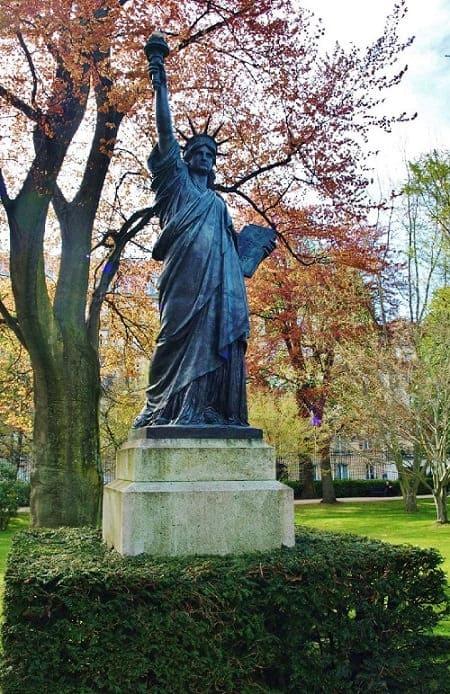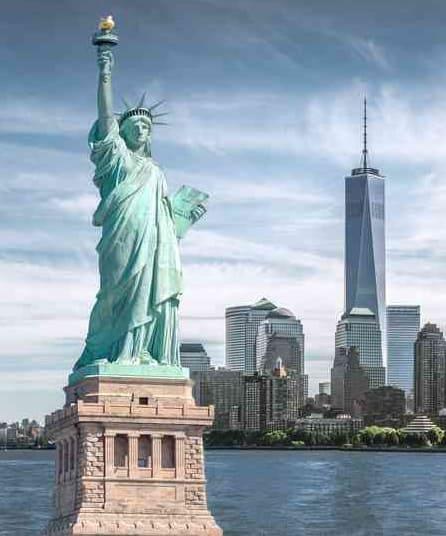The Statue of Liberty is that huge bronze statue that dominates the mouth of the Hudson River and is located south of Manhattan. It was a good gift that the French people made in 1886, to the American people to commemorate the Declaration of Independence of the United States of 1776
The French sculptor Frédéric Auguste Bartholdi was in charge of designing it and carrying out its construction. The engineer Gustave Eiffel, whom we all know from the tower that bears his name, was working on this project; specifically manufacturing the internal structure.
The Statue of Liberty was established as a United States National Monument in 1924 and its maintenance is under the responsibility of the National Park Service. Its height is 310 feet and it weighs 225 tons. In 1984 UNESCO declared it a World Heritage Site
The staircase leading to the head has 354 steps. The crown has 7 peaks representing the 7 seas and this option was chosen before the classic Phrygian hat with which freedom is usually represented.
The board in his left hand is engraved with the date of North American Independence July IV MDCCLXXVI. At its base is a bronze plaque with the stanzas of a poem by the American poet Emma Lazarus, placed in 1903, where she declares this " powerful woman with a torch ... the Mother of the exiles ... " since the immigrants who arrived at New York, the first thing they saw was this statue, and in which they hoped.
But it turns out that there are three statues of liberty made by the same sculptor, identical to the one in NYC, but smaller in size.
Statue of Liberty Patent
On February 18, 1879, Bartholdi obtained the patent for the monument in the United States, USD11023S. This patent described it in the following terms:
"... a statue representing Liberty that illuminates the world, which consists, essentially, of a covered female figure, with one arm raised, holding a torch, and while the other holds an inscribed plaque, and has on his head a diadem, ... "
Ile des Cygnes - Sena River - Paris - France - 1898
One is located next to the Pont de Grenelle and at one end of the Swan Island on the Seine river, in Paris - France. In reality, the Paris Statue of Liberty is an exact, smaller reproduction of the other; It is made of bronze and is at the end of the Ile des Cygnes.
It is 38 feet high and was a gift from the United States to the city of Paris on the occasion of the Universal Exhibition of 1898. In 1937 its position was modified, turning it to the west, so that it looked towards its monumental sister in New York.
Luxembourg Palace Gardens - Paris - France - 1906
Another smaller one is in the Luxembourg Palace Gardens, Paris France. This Statue of Liberty in the Luxembourg Gardens has the originality of being one of the sketches that Auguste Bartholdi made to serve as an image of the great statue that is in Manhattan.
On the occasion of the Universal Exposition held in Paris in 1900, Bartholdi himself gave the city of Paris this statue, which was not placed in its current place until six years later in 1906. Bartholdi had died two years earlier.

This statue is located at a crossroads very close to the fence that separates the gardens from Rue Guynemer. The oak that gives it shade was planted by the President of the French Senate, M. Christian Planchelet and by Howard Leach, American ambassador to France. This oak was planted to remember the victims of the terrorist attacks of September 11, 2001 in the United States.
The last statue of liberty of Bartholdi is in Argentina, more precisely in the city of Buenos Aires. It is located on a traditional promenade in the Barrancas de Belgrano neighborhood. On the corner of La Pampa and Arribeños streets. The material of this statue is cast iron received in copper. Its height is 10 feet

It was made by Bartholdi himself, it was inaugurated on 1886, by President Julio Argentino Roca, who was to deliver the presidential band to his successor Miguel Juárez Celman nine days later. At the foot of the statue you can verify the signature of its author, A. Bartholdi, and the legend Fonderie d'art du Val d'Osne. 68, 8 rue Voltaire, Paris.
Design History of the Statue of Liberty
During a visit to Egypt, Bartholdi imagined a large lighthouse, to be found at the entrance to the Suez Canal, which would mark the routes. The lighthouse was devised as the classic-looking image of the goddess Libertas from Roman mythology, divinity of liberty. It was designed so that the headlight light would shine through a bandage placed around the top. The idea also arose of a torch held in the air, towards the sky.

Bartholdi presented the project to the Ismail Pachá Jedi in 1867 and again in 1869, but the project was never approved. The drawings for the project entitled "Egypt Brings Light to Asia" closely resemble the Statue of Liberty. Bartholdi assured that the New York monument was not a reuse, but an absolutely original work.

